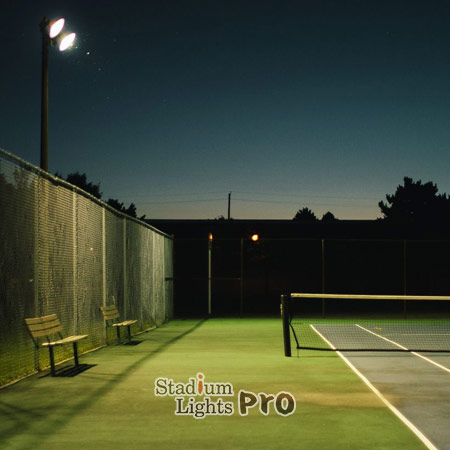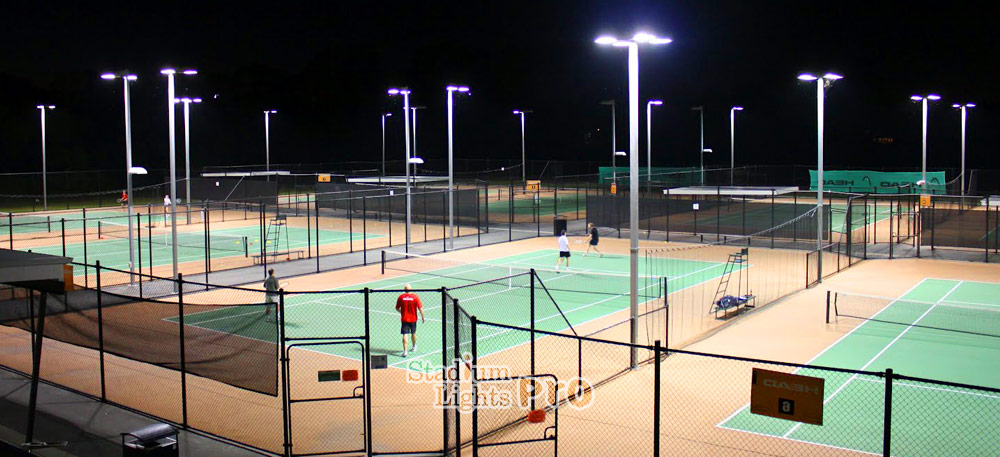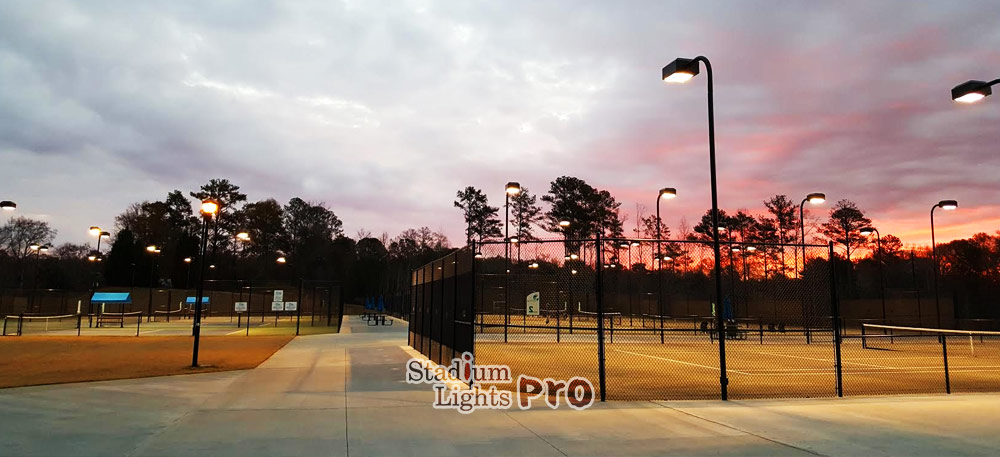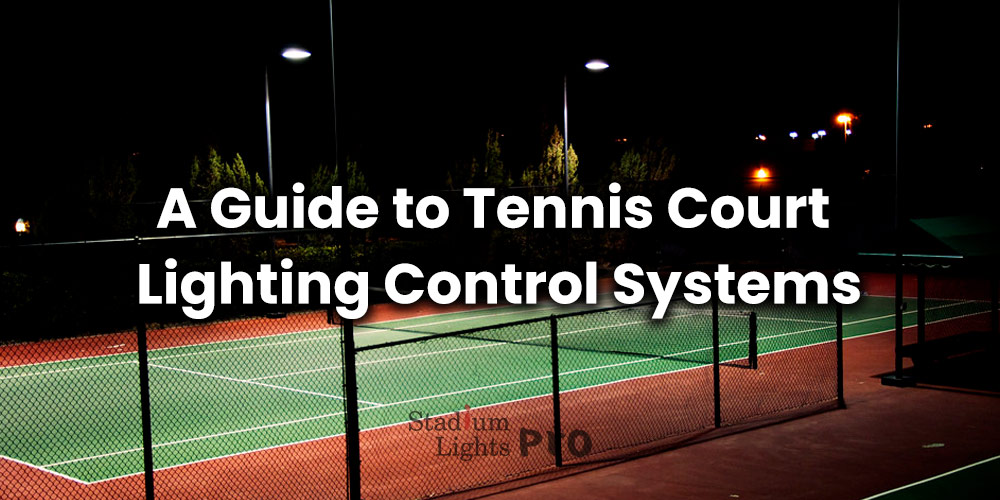A tennis court lighting control system is a system that is used to control and regulate the lighting in a tennis court. It includes a variety of components, such as light fixtures, control panels, sensors, and wiring, that work together to ensure that the lighting in the court is sufficient for players to see and play comfortably.
Tennis court lighting control systems can be manual, automatic, or timer-based, depending on the specific needs and preferences of the facility. The main purpose of a tennis court lighting control system is to provide sufficient and appropriate lighting for tennis games and practices, while also optimizing energy efficiency and convenience.
Table of Contents
ToggleTypes of tennis court lighting control systems
Manual control systems
 Manual control systems are a type of tennis court lighting control system in which the lighting is controlled manually by the user. This means that the user must manually turn the lights on and off, as well as adjust the intensity of the lighting, using a switch or a dial.
Manual control systems are a type of tennis court lighting control system in which the lighting is controlled manually by the user. This means that the user must manually turn the lights on and off, as well as adjust the intensity of the lighting, using a switch or a dial.
These are the simplest and most basic type of tennis court lighting control system. They are often used in small facilities or in cases where there is only a limited need for lighting control. However, manual control systems can be inconvenient and labor-intensive, as the user must constantly adjust the lighting as needed.
The user typically has complete control over the lighting in the court, including the ability to turn the lights off or on, adjust the intensity, and switch between different lighting modes. However, manual control systems do not offer the same level of energy efficiency or convenience as automatic or timer-based control systems.
Automatic control systems
Automatic control systems are a type of tennis court lighting control system in which the lighting is controlled automatically, without the need for manual intervention. These systems use sensors and control panels to automatically adjust the lighting based on a variety of factors, such as the time of day, the presence of players on the court, and the amount of natural light available.
Automatic control systems are more advanced and sophisticated than manual control systems, and offer a number of benefits. They are more convenient and efficient, as they do not require the user to constantly adjust the lighting. They are also more energy-efficient, as they can automatically turn the lights off or dim them when they are not needed.
The user typically sets the desired lighting levels and schedules, and the system takes care of the rest. Some automatic control systems also offer advanced features such as the ability to adjust the lighting based on the position of the sun or the weather conditions. Automatic control systems are commonly used in large facilities or in cases where there is a high demand for lighting control.
Timer control systems
Timer control systems are a type of tennis court lighting control system in which the lighting is controlled based on a predetermined schedule set by the user. These systems use a timer or a clock to turn the lights on and off at specific times, and can also be used to adjust the intensity of the lighting.
The systems offer a level of convenience and energy efficiency, as they can be programmed to turn the lights on and off at specific times, such as when the court is in use or when the facility is closed. However, timer control systems do not offer the same level of flexibility or adaptability as automatic control systems, as they do not respond to real-time changes in lighting conditions or player presence.
They are often used in small or medium-sized facilities, or in cases where there is a moderate demand for lighting control. They are a simple and cost-effective option for facilities that do not require the advanced features of an automatic control system.
Components of a tennis court lighting control system
Light fixtures

Light fixtures are the devices that provide the actual illumination for the court, and can be mounted on poles, walls, or other structures.
There are several different types of tennis court light fixtures in a control system, including:
Floodlights
These are large, powerful lights that are used to illuminate a wide area. They are often mounted on poles and can be adjusted to focus the light in different directions.
Spotlights
These are smaller, more focused lights that are used to highlight specific areas or objects. They are often mounted on walls or poles and can be adjusted to aim the light in different directions.
LED lights
LED (light emitting diode) lights are energy-efficient and long-lasting, making them a popular choice for tennis courts. They can be used in a variety of light fixtures, including floodlights and spotlights.
Control panel
The control panel is a central component of a tennis court lighting control system. It is the device that allows the user to control and regulate the lighting in the court. The control panel typically consists of a series of switches, dials, or buttons that can be used to turn the lights on and off, adjust the intensity of the lighting, and switch between different lighting modes.
In manual control systems, the control panel is typically located near the lights and can be easily accessed by the user. In automatic or timer-based control systems, the control panel may be located remotely, and may be accessed through a computer or mobile device.
It allows the user to easily control the lighting in the court and make any necessary adjustments. We may choose a control panel that is easy to use and understand, and that offers the features and functionality needed for the specific requirements of the facility.
Sensors
Sensors are devices that detect changes in the environment, such as the presence of players on the court, the level of natural light, or the temperature, and use this information to adjust the lighting accordingly.
Photoelectric sensors

These sensors detect changes in the level of natural light, and can be used to turn the lights on or off, or to adjust the intensity of the lighting, based on the amount of sunlight available.
Occupancy sensors
These sensors detect the presence of people in a specific area, and can be used to turn the lights on or off, or to adjust the intensity of the lighting, based on whether the court is in use or not.
Temperature sensors
These sensors detect changes in temperature, and can be used to adjust the lighting or ventilation in the court to maintain a comfortable environment for players.
Wiring and connectors
Wiring and connectors are essential components of a tennis court lighting control system, as they are used to connect the various components of the system together. The wiring is typically made of insulated electrical wire, and is used to carry electricity from the power source to the light fixtures and other components of the system. The connectors are devices that are used to join the wires together, and can be either mechanical (such as wire nuts or terminal blocks) or electrical (such as plugs or sockets).
Properly installed and maintained wiring and connectors are essential for the safe and reliable operation of a tennis court lighting control system. We may use the appropriate type and gauge of wire for the specific requirements of the system, and to properly secure and protect the wires to prevent damage or accidents. Regular inspections and maintenance of the wiring and connectors can help to ensure the continued functionality and safety of the lighting control system.
Advantages of using a tennis court lighting control system
Improved visibility and safety
Tennis court lighting control systems can help to improve visibility and safety in a number of ways. For example:
By providing sufficient lighting levels
Tennis court lighting control systems can be used to ensure that the lighting in the court meets the recommended levels for visibility and safety. This can be achieved by using the appropriate light fixtures and control settings, and by regularly inspecting and maintaining the lighting system.
By adjusting the lighting based on the time of day
Automatic or timer-based control systems can be programmed to adjust the lighting levels based on the time of day and the availability of natural light. This can help to ensure that the lighting is optimal for the specific conditions of the game or practice.
By using sensors to detect changes in the environment
Automatic control systems that use sensors can detect changes in the environment, such as the presence of players on the court or the level of natural light, and adjust the lighting accordingly. This can help to improve visibility and safety by ensuring that the lighting is always sufficient for the specific needs of the players.
Energy efficiency
By using energy-efficient light fixtures
LED (light emitting diode) light fixtures are a popular choice for tennis courts, as they are energy-efficient and long-lasting. They use less energy than traditional incandescent or halogen light fixtures, and can help to reduce energy costs and greenhouse gas emissions.
By dimming or turning off the lights when they are not needed
Automatic or timer-based control systems can be programmed to turn the lights off or dim them when the court is not in use, which can help to reduce energy consumption.
By using sensors to adjust the lighting based on the environment
Automatic control systems that use sensors can detect changes in the environment, such as the presence of players on the court or the level of natural light, and adjust the lighting accordingly. This can help to optimize energy efficiency by ensuring that the lighting is only turned on when it is needed.
Convenience and ease of use
A system that is easy to use and understand can help to make the process of controlling the lighting in the court more efficient and hassle-free.
Tennis court lighting control systems can offer a number of convenience and ease-of-use features, including:
Remote control
Some control systems can be accessed and controlled remotely, using a computer or mobile device. This can be convenient for users who need to adjust the lighting from a distance or who are not physically present at the court.
User-friendly interfaces
Control panels and other interface devices should be easy to use and understand, with clear and intuitive controls and displays.
Automatic controls
Automatic control systems can adjust the lighting based on pre-set schedules or real-time changes in the environment, without the need for manual intervention. This can be convenient for users who do not want to spend time adjusting the lighting manually.
Easy maintenance
A lighting control system that is easy to maintain and repair can be more convenient for users, as it requires less time and effort to keep it functioning properly.
Maintenance and upkeep of a tennis court lighting control system
Regular inspections and testing
Regular inspections can help to identify and address any issues or problems with the system, and can prevent costly and inconvenient breakdowns or failures.
Inspecting the light fixtures
Light fixtures should be inspected regularly for any visible signs of wear or damage, such as broken or missing bulbs, loose connections, or damaged housings. Any faulty or damaged light fixtures should be repaired or replaced as needed.
Testing the lighting levels
The lighting levels in the court should be tested regularly to ensure that they meet the recommended levels for visibility and safety. This can be done using a light meter or other measuring device.
Checking the control panel
The control panel should be checked regularly to ensure that it is functioning properly and that all controls are working as intended. Any problems or malfunctions should be repaired or replaced as needed.
Testing the sensors
Sensors should be tested regularly to ensure that they are working properly and are accurately detecting changes in the environment. Any faulty or malfunctioning sensors should be repaired or replaced.
Cleaning and dusting of light fixtures
Light fixtures can accumulate dust and dirt over time, which can reduce their efficiency and effectiveness. Regular cleaning and dusting of the light fixtures can help to improve their performance and extend their lifespan.
Turn off the lights
We need to turn off the lights and unplug any electrical connections before cleaning or dusting the light fixtures. This can help to prevent accidents or injuries, and can also protect the light fixtures from damage.
Dust and wipe the fixtures
Use a soft, dry cloth or a microfiber duster to gently remove any dust or dirt from the light fixtures. Be careful not to scratch or damage the fixtures, and avoid using harsh chemicals or abrasive cleaning materials.
Clean the bulbs
If the bulbs are dirty, you can use a soft, dry cloth to gently wipe them clean. Be sure to handle the bulbs carefully, as they are fragile and can break easily.
Check for damage
While cleaning the light fixtures, inspect them for any visible signs of wear or damage. If you notice any problems, such as broken or missing bulbs, loose connections, or damaged housings, you should repair or replace the fixtures as needed.
Conclusion
A tennis court lighting control system is a system that is used to control and regulate the lighting in a tennis court. It can consist of a variety of components, including light fixtures, control panels, sensors, wiring and connectors, and other devices. There are several different types of tennis court lighting control systems, including manual, automatic, and timer-based systems, which offer different levels of flexibility and energy efficiency. Properly installed and maintained tennis court lighting control systems can help to improve visibility and safety on the court, optimize energy efficiency, and provide convenience and ease of use for users. Regular inspections and testing, as well as cleaning and maintenance activities, are essential for the proper functioning and upkeep of a tennis court lighting control system.
If you are interested in getting a professional lighting design and layout for your tennis court, we can help. Our team of experts can create a customized lighting system that meets your specific needs and requirements, and provide you with a detailed plan for installation.
We offer a wide range of lighting options for tennis courts, including LED light fixtures, automatic and timer-based control systems, and advanced sensors and controls. We can assist you in choosing the right components for your specific needs, and provide guidance on installation, maintenance, and upkeep of the lighting system.
Contact us to start your free tennis court lighting design and layout and improve the lighting in your facility.

